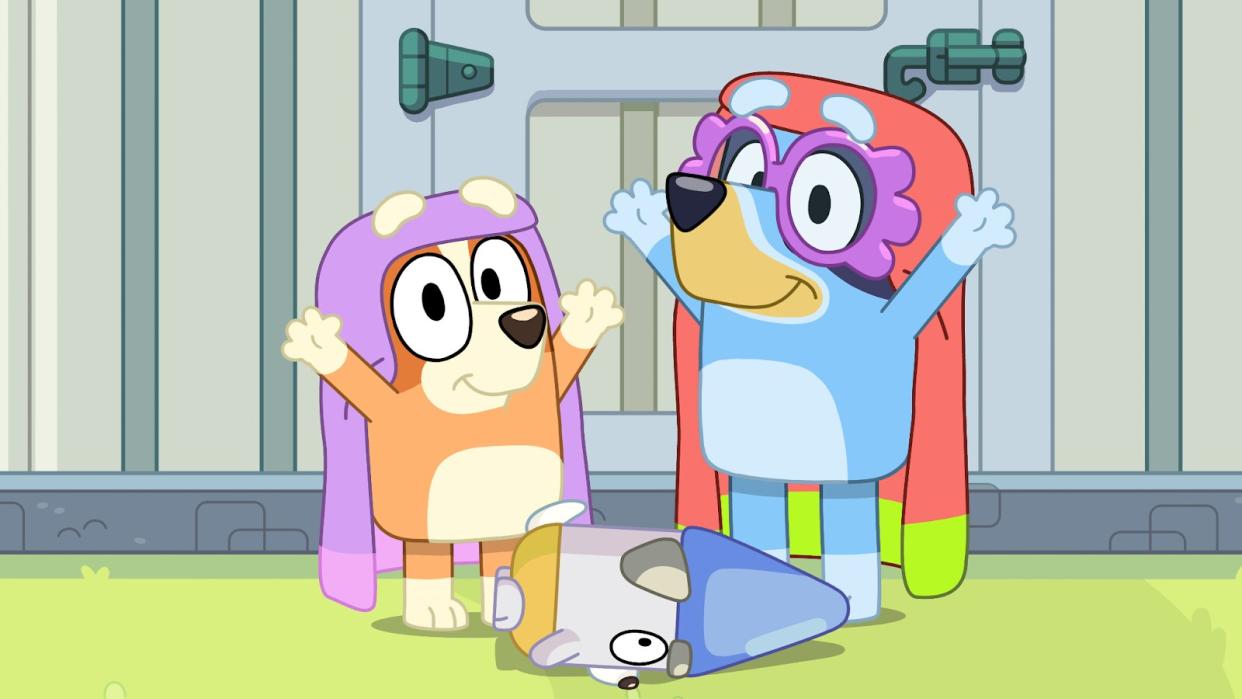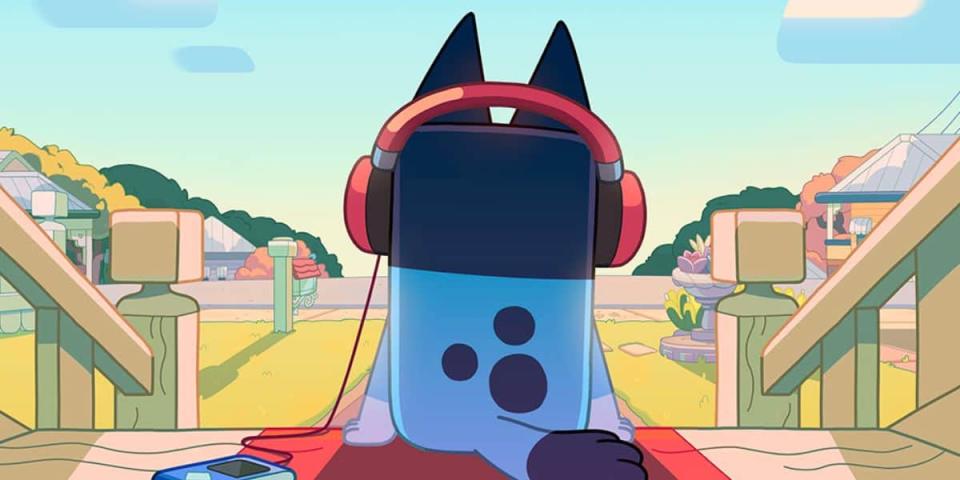An Ode to the Music of ‘Bluey’

When The Jonas Brothers open their show in Brisbane by walking out to your animated kid show’s theme tune, then that theme song and that show have done way more than entertain some 6-year-olds. The show in question, “Bluey,” has been a phenomenon for a while — it’s approved by the kids of “Abbott Elementary” as well as millions worldwide — and the music by composer Joff Bush and a coterie of talented collaborators has fueled two albums and untold instances of “Dance Mode.”
Music has always anchored the wordless sequences where “Bluey” reaches its most poignant heights — whether gently cribbing from Gustav Holst as younger sister Bingo swims past the planets in her dream in “Sleepy Time” or ever-so-slightly tweaking a recurring theme as Rusty walks off the cricket pitch in “Cricket” and high fives his future self as that Rusty steps up to a much bigger stage. But the latest, longest episode of “Bluey” yet, “The Sign,” comes in at a whopping 28 minutes, compared to the series’ usual seven(ish) minutes of playing fun new games and exploring new big emotions.
More from IndieWire
Bush and his team meet that challenge not just by composing more music but by mirroring the structure of the episode in the types of music we hear in “The Sign.” The episode should be a big culmination of things: Frisky (Claudia O’Doherty) and Rad (Patrick Brammall) are getting married in the Heelers’ backyard, but Bandit (David McCormack) and Chilli (Melanie Zanetti) are also selling the house, set on moving to a bigger city so Bandit can pursue a better-paying job. Bluey is, naturally, upset at the upcoming change, and her teacher Calypso (Meg Washington) tells her a story of a farmer who refuses to read good or bad luck in the things that happened to him, always saying instead, “We’ll see.”
Bluey isn’t quite ready for that kind of ambiguity and takes Calypso’s word that everything will work out as proof that no one will buy the Heelers’ house — especially if Bluey removes the “For Sale” sign in front of the house. There follows a series of events that are both good and bad at different points — Frisky is ready to call the wedding off (bad), so Chilli and all the Heeler cousins chase after her in the family car, which means that Bluey gets to sit in the front seat (amazing); the girls finding a lucky penny (hooray!) means they miss seeing Frisky at a juice bar (oh beans), but can put the penny in a binocular set later on when they find her brooding at a lookout point, and so on.
The music feels like the same kind of Rube Goldbergian contraption of moments that ripple out in ways the characters couldn’t have predicted. Bush brings back old themes and songs at key moments (all of the adults singing “Cat Squad” while they prep the house for the wedding gives us the gift of feeling like we’re part of Heeler parents’ inside joke), particularly around the wedding itself. There’s an even fuller version of “Dance Mode,” too, timed to the glorious way that the camera bounces along with Muffin, Socks, and Bingo on the dance floor.
But it’s not just references to previous episodes that make this score feel like the culmination of what the music on “Bluey” does well. In interviews, Bush has described scoring for kids’ shows as a task that can often boil down to “hear a carrot, see a carrot.” In other words, writing an externally motivated score. The music on “Bluey” never clashes with the primary emotion of a scene, but it often is a lot more psychologically grounded in the experience of that scene’s key characters.
For instance, instead of finding music that sounds generically triumphant or accomplished, Bush will trace out a tentative, first-time-at-the-piano version of “Ode to Joy” over the course of an episode (“Bikes”) and then have it come together at the moment the girls accomplish something at the end. It feels like the music learned right along with the characters.

In “The Sign,” Frisky and Rad’s wedding montage gets similar treatment, with the barest hints of a traditional processional on horns as part of a warmer track that breezes from percussion bops to electric guitar, mirroring the fidgety fun that the event is for Bluey.
But Bush’s music is often the voice of the show itself. As Calypso reads the story of the farmer to Bluey in class, we hear a very delicate, string-led variation on a theme the show has used for the Heeler home (and Brisbane, generally), with a bit of Eastern flair to match the pop-up animation style of the story. Then, towards the end of the episode, when Bingo finally realizes that selling the house means they will have to leave and Bluey tells her the story of the farmer as a comfort, the musical idea returns. Only now it’s more confident, with more strings and a trilling flute and a longer crescendo; the score, like Bluey, gets the satisfaction of using something you’ve learned to comfort someone you care about. And, whether the audience clocks it or not, the score’s associations in previous episodes tie both moments to Bluey’s dilemma of leaving home.
The score transforms itself as Bluey grows, whether that’s learning a lesson, experiencing a particularly joyful or wonderful moment, or expanding her imagination (the musical language of Bluey and Bingo as The Grannies is pretty different from the rest of the show and pretty perfect). But there’s something that feels transformative for the show itself, whenever it eventually returns for a Season 4, in the track with which “The Sign” ends.
The song is called “Lazarus Drug,” and it’s sung by Meg Washington, who also voices Calypso. It first appeared on her album “Batflowers,” but she, Bush, and the “Bluey” team adapted it to the season finale. Beyond the pleasing circularity of her voice being the episode’s bookend, the surging electronic build-up to the vocals feels completely outside of what’s come before on “Bluey” and for Bluey. The nerviness of the score, combined with nearly still shots of the empty house, is what pushes us to the precipice of this impending, scary change alongside Bluey. And it is Washington’s voice that punches through that anxiety, gently guiding the final beats of the story.
Great music almost always makes us feel something and great film and TV scores are adept at introducing ideas that add to our understanding of the story. But it’s rarer and much more magical when music makes us feel like we’re making a memory along with the characters, like the joy is ours. The music of “Bluey” is what makes the show feel real, for real life.
Best of IndieWire
The 22 Best Spy Movies, from 'Enemy of the State' to 'North by Northwest'
The 12 Best Thrillers Streaming on Netflix in April, from 'Fair Play' to 'Emily the Criminal'
Quentin Tarantino's Favorite Movies: 61 Films the Director Wants You to See
Sign up for Indiewire's Newsletter. For the latest news, follow us on Facebook, Twitter, and Instagram.

